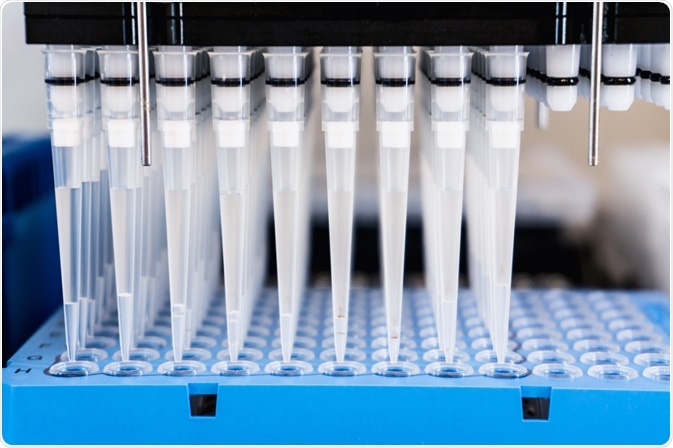High-throughput screening is a tool that has been developed to screen millions of biological and chemical compounds in very short periods. The application of high-throughput screening has particularly been of paramount significance in the drug discovery process. This automated process enables very large numbers of chemical or biological compounds to be investigated for their therapeutic potential.
The process has also been shown to accelerate the discovery of drugs that are potentially of great therapeutic promise when compared with other screening methods.

Image Credit: Elpisterra/Shutterstock.com
What Information does High-Throughput Imaging provide?
The process of high-throughput screening in drug discovery involves screening a large library of compounds to find potential candidate compounds that affect a biological target. These candidate compounds are often referred to as ‘hits’.
For example, in a study by Das et al, 2006, a compound now called ‘Dasatinib, BMS-354825’ was identified as a potent pan-SRC kinase inhibitor for the biological target of diabetes.
High-throughput screening processes can be achieved through various methods including detectors such as robotics or plate readers and corresponding software to process and analyze the data obtained. Once these potential ‘hits’ have been discovered, further analysis of the high-throughput screening data can also provide information on potential optimization for these ‘hits’ that were obtained during the first round of screening.
It is important to understand that high-throughput screening alone cannot be used to completely evaluate a potential drug as toxicity studies are further needed for this evaluation. Instead, high-throughput screening is essential to eliminate the time that would have been wasted on investigating compounds that had little or no desired effect on the biological target. Through the utilization of this automated screening process, millions of compounds can together be screened and compounds with no or poor effects eliminated.
The process of High-Throughput Screening
Primarily, as large numbers of samples are needed to be screened, microplates that have up to 3456 wells are often used as the platform to hold the samples. Additionally, automation is a process that plays an integral part in the high-throughput screening process. This is because automation essentially enables millions of compounds to be rapidly screened in several weeks as opposed to laboratory benchtop investigation of compounds by researchers in the same period.
However, for the process to be automated, the experiment must be designed within the constraints presented by automation. In the case of using microplates to screen potential compounds, this could mean that the quantity of reagents added to each well of a microplate has to be minimized.
Alternatively, other challenges presented by automating the process include limiting the adjustments that can be made to compounds through the screening process. The experimental design often has to be limited to one single injection of compounds to target samples as other adjustments to how compounds are added to samples would mean that the experimental design is no longer suitable for automation.
A further process involved in high-throughput screening is a robotic configuration. Often a robotic system is incorporated into high-throughput screening platforms to accelerate the time by which data is acquired.
The system essentially would be able to perform multiple functions such as adding reagents, transferring microplates, mixing samples, and incubating samples at specific temperatures. This enables both experimental times to be reduced and the elimination of any error that could potentially be brought about if the process was carried out manually.
Miniaturization
A challenge that is currently presented with high-throughput screening for drug discovery is miniaturization. As it is a vital necessity to keep costs at a minimum, ideally quantities of samples that are as small as possible should be used but should also be enough to be able to produce reliable results.
Currently, the usage of high sensitivity microplates for high-throughput screening that can reliably measure signals from small sample sizes means that miniaturization has already been achieved to a certain extent.
However, it is expected that in the future further miniaturization of the screening process can be achieved, thus reducing costs of the process even more than current high-throughput screening technology.
Conclusion
The increasing pressure faced by drug discovery companies to identify potential therapeutic drugs, approve them, and bring them into the market, means that a rapid tool to speed up the process of drug discovery is necessary. The usage of high-throughput screening technology has become widespread and gained greater importance in the drug discovery process by pharmaceutical companies and researchers.
The technology enables large libraries of compounds to be screened in short periods for the identification of potential drug candidates.
References:
- Coma, I. et al. Process validation and screen reproducibility in high-throughput screening. J. Biomol. Screen. 14, 66–76 (2009).
- Das, J. et al. 2-aminothiazole as a novel kinase inhibitor template. Structure-activity relationship studies toward the discovery of N-(2-chloro-6-methyl phenyl)-2-[[6-[4-(2-hydroxyethyl)- 1-piperazinyl)]-2-methyl-4- pyrimidinyl]amino)]-1, 3-thiazole-5-carboxamide (Dasatinib, BMS-354825) as a potent pan-Src kinase inhibitor. J. Med. Chem. 49, 6819–6832 (2006).
- Houston, J. G. et al. Case study: impact of technology investment on lead discovery at Bristol-Myers Squibb, 1998–2006. Drug Discov. Today 13, 44–51 (2008).
Further Reading
Last Updated: Jan 12, 2021